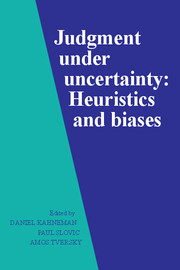Book contents
- Frontmatter
- Contents
- List of contributors
- Preface
- Part I Introduction
- Part II Representativeness
- Part III Causality and attribution
- Part IV Availability
- Part V Covariation and control
- Part VI Overconfidence
- Part VII Multistage evaluation
- Part VIII Corrective procedures
- Part IX Risk perception
- Part X Postscript
- References
- Index
Preface
Published online by Cambridge University Press: 05 May 2013
- Frontmatter
- Contents
- List of contributors
- Preface
- Part I Introduction
- Part II Representativeness
- Part III Causality and attribution
- Part IV Availability
- Part V Covariation and control
- Part VI Overconfidence
- Part VII Multistage evaluation
- Part VIII Corrective procedures
- Part IX Risk perception
- Part X Postscript
- References
- Index
Summary
The approach to the study of judgment that this book represents had origins in three lines of research that developed in the 1950s and 1960s: the comparison of clinical and statistical prediction, initiated by Paul Meehl; the study of subjective probability in the Bayesian paradigm, introduced to psychology by Ward Edwards; and the investigation of heuristics and strategies of reasoning, for which Herbert Simon offered a program and Jerome Bruner an example. Our collection also represents the recent convergence of the study of judgment with another strand of psychological research: the study of causal attribution and lay psychological interpretation, pioneered by Fritz Heider.
Meehl's classic book, published in 1954, summarized evidence for the conclusion that simple linear combinations of cues outdo the intuitive judgments of experts in predicting significant behavioral criteria. The lasting intellectual legacy of this work, and of the furious controversy that followed it, was probably not the demonstration that clinicians performed poorly in tasks that, as Meehl noted, they should not have undertaken. Rather, it was the demonstration of a substantial discrepancy between the objective record of people's success in prediction tasks and the sincere beliefs of these people about the quality of their performance. This conclusion was not restricted to clinicians or to clinical prediction: People's impressions of how they reason, and of how well they reason, could not be taken at face value.
- Type
- Chapter
- Information
- Judgment under UncertaintyHeuristics and Biases, pp. xi - xivPublisher: Cambridge University PressPrint publication year: 1982
- 5
- Cited by



